

|
Racing for the First Time The San Diego Classic By Bill Mattson Being the editor of "On The Wire", I've been asked a few times if Frank and I are famous in the sailing world. The truth is, we're only famous through the exploits of this website. (Frank is famous down at the Henry Mayo Hospital in Santa Clarita, but that's another story.) Anyway, we're both strictly recreational sailors. Well... I was until the San Diego Classic. So, if you veteran racer readers are looking for some valuable tactical insight in this article, forget it. It's more a story of the experiences of a first time racer, one that might encourage other recreational sailors to give it a try. The veterans may enjoy it too, as it may bring back some memories, as well as remind them of what's going on in the mind of that C class boat skipper rapidly closing on a collision course. My son (crew) and I have talked about racing for the past 2 years, but never took the opportunity to do so. While surfing the net, I came across Fleet 4's site, and a page describing the San Diego Classic held at Fiddler's Cove in San Diego. With only about a week's notice, and a 4 hour drive, I figured we'd give it a shot. First, I called Jay Petit, who's name I found on the flyer. I told him of my anxieties, since we had never raced before. He took the time to answer my questions, and basically told me that I would have a great time if I came down. Next, I emailed Frank Mardel, who also eased my concerns, bue and told me that my 10 o'clock arrival time would cutting it a bit slim. (Later, I was really glad I left earlier as he had suggested.) During the week I did some searching on the Internet for information on how regattas are run, as well as getting familiar with the rules. It's hard to believe, I actually cancelled my weekly Friday night poker game so that I could get ready for the race. The card game has become sort of a sacred weekly ritual, and the acceptable excuses for being absent are limited. But since I host the game, I guess I get cut some slack. Anyway, I spent the evening getting the camping gear loaded and the boat ready to go. To be in San Diego by 8:30am, we had to leave the house at 5, thus I had to get my son out of bed at 4. Interestingly, I usually have to struggle to get him up for school at 7, but on this particular saturday, he was up and ready to go before I even got out of bed. My wife was also up. Having watched this sport from a confortable distance, and familiar with Frank's emergency room experience, I figure she wanted to see us off "this last time". We hitched the boat, and drove off into the morning darkness. We arrived in San Diego right on time, and near the Hotel Coronado, we came across another Hobie sailor with boat in tow. Not entirely sure where to go, we followed them the rest of the way, and soon arrived at Fiddler's Cove Marina. After registering, we made our way down a narrow dirt road to the beach. Here, we found lots and lots of Hobies. (I found out later that 93 boats were entered in this event.) After backing the trailer into the sand, I determined that when I purchased the Toyota 4Runner, the 2 wheel drive model may not have been such a good idea. Rather than bury the truck to the axles, I unhitched the trailer where it sat, and got the vehicle out of there. We then dragged the boat across the sand to the water, and decided to worry about the trailer later. A couple from Arizona was on the beach next to us, and offered to help with their 4 wheel drive when the need arose. |
|
After getting the boat ready, we went to the skipper's meeting at 10am. (It's probably that "Hobie
Way of Life" thing, but about 1/4 of the skippers were there at 10am, and about 1/2 were there when the
meeting started about 20 minutes later.) Anyway, Jay Petit and Frank Mardel gave a presention on
how things would be run, and Thomas and I followed along as best we could. Rolling starts, 5 minutes
apart. Did he say the 16s after the 17s? Or was that the 18s? (Tip: Bring a notepad.) And what's so
funny about this white flag, yellow flag thing? And why do I have to wait until I'm on the water to
know what course I'm going to run? Why not just tell me now?
Near the end of the meeting, a guy named Jeff Petron stepped up and made an announcement about the Blue Water Regatta in Ventura on July 19 and 20. Since Ventura is |
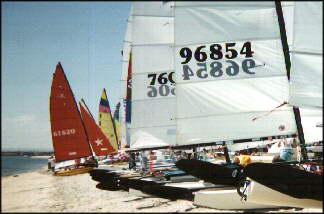
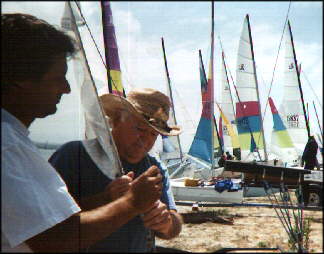
|
| about 20 min. from my home, I approached Jeff after the meeting for details. Also, Jeff gave us tips on racing, drawing a race course in the sand while explaining the basics. Like when the 16s would be starting, and that wind conditions at the time would dictate what course would be run. |
|
"You guy's have a course sticker?"
"Uh... no...." "They have some at the registration desk." So off we went to get a nice sticker showing the mark sequences of each numbered course. The same ones Thomas was reading and memorizing all the way down Interstate 5. (He takes crewing very seriously). We also got a yellow ribbon to attach to the leech of the sail. A red ribbon at the boom says, "I'm an A Fleeter. A blue ribbon on the first |
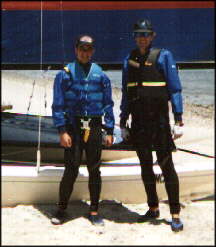
Crew Thomas Mattson and Skipper Bill Mattson (Left to Right) |
|
batten says, "I'm a B fleeter. A yellow ribbon on the 2nd batten up says, "Keep the your A
and B Fleet boats the heck away from me. I'm a C Fleeter."
Once the boat was rigged, and we were suited up, we launched and began sailing to the racing area. Once we got there, it was a bit unnerving. Close to 100 boats parked around the area, with a committee boat nearby. Just before a start, a group of boats belonging to the respective class would start to converge. The flag would drop, the horn would sound, and off they would go. We decided that we would be a "follower" in the first race. We spotted a couple of C fleet H16s and kept an eye on them prior to the start. We were grossly out of position for the first start, and came over the line last. But hey, we were racing!  Now that's a lotta boats! For some reason, I had this view in my mind that this was going to look something like a stock car race. A nice tidy line, going around the track. This assumption was proven wrong as half the boats went to a port tack and the others continued on starboard. We "followed" the later group as best we could. |
|
I say "as best we could" because it was tough. At this point, I learned the big difference between
recreational sailing and racing. Recreational sailing is finding that slot, and screaming across
the water, flying the hull on the perfect reach. Racing is getting around the marks, and getting around
A mark means you have to point, and point high. I've got quite a bit of sailing experience, and thought I could point my
Hobie fairly high. My first trip to A mark with other boatsproved I couldn't point for crap. It was
obvious that the boat was not rigged quite right on that first trip to A mark.
What was entertaining though, was how well we did on a broad reach. I'm still not sure if it was the near upright mast, or our light weight, or whatever. When we got on a broad reach, we lifted one rudder, got our weight forward, and kicked butt. After rounding a couple of marks, things got confusing. Our strategy of "following" was getting difficult with the number of boats on the water. Also, we were pretty damn sure we were supposed to be running course 3, which implied initially rounding A mark, then C mark. But the boats in our class rounded A, then B! Later, we learned that in tacking downwind, boats were naturally rounding B on the way to C. We did manage to find the finish line, although there was no one to follow at this point. 8th out of 8 boats in the first race. We did manage to come in 7th on of the races on the first day. We assumed one of the competitors had sunk. In one of the races, we were on a close reach on the last leg, running just windward of another boat. We were trying to estimate when to take the last port tack to the finish line. We made the tack, but found ourselves on a very close reach. Our friends continued on the starboard tack for quite a bit further, then tacked to port, then kicked our butt to the finish. Skill, experience, and discipline. This is a great sport. |
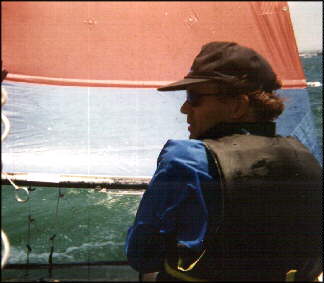 The author at the helm. 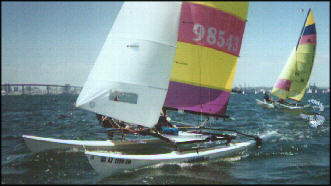 Some close competitors. 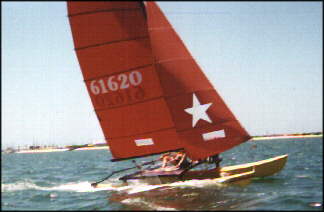 Jon pinching us to B mark. 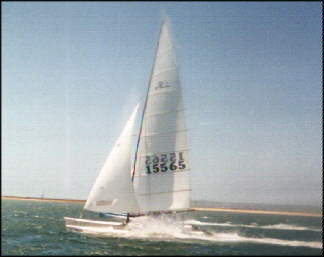 Not lookin' back! |
|
Another diffence from recreational sailing is that racing really tires you out. After the first race, we
had been on the water for about an hour and half, but it felt like we had been racing all day. The only time
you're not sailing as fast as you can, is when your tacking. And then, you're tacking as fast as you
can. All the while, you're taking peeks under the boom to make sure you're not going to kill anybody. At
one point, we nearly collided with a group of boats (17s, I think) which were finishing. We were trailing a
group of about 4 boats on the way to A mark, and they crossed an area just behind the finish line. We were
doubled trapped, and I had my concentration on the boats ahead of me, when I started hearing a lot of
yelling from behind my sail. I sheeted out, took a partial dunk in the water, and watched the finishing boats
cross my bow. My apologies to any readers who may have been in this finishing group. (I'm thinking
of having a windows sewn into the sail.)
After racing, we beached the boat, took a breather, then took a ride down to the showers. I'm not sure how big the hot water heaters were, but they were not adaquate to support steaming hot showers for 93 skippers and crew. The water was cold, but refreshing. We then went to the dinner and party. The mexican food was excellent, and the beer tap was flowing freely. The live band began playing later, with plenty of Jimmy Buffet tunes on agenda. When the ultimate party song "Louie, Louie" started, I ran out to the car to get the car phone. I figured it was a good opportunity to call Frank, and let him know what a great time he wasn't having. |
|
We spent the first night sleeping in sleeping bags thrown over the trampoline of the H16. (Camping note:
If you are going to bring a really nice, 3 room, $350 tent, don't leave the poles at home.) There are
misquitos at Fiddler's Cove, by the way. But in our case, it appears they only enjoy feasting on the
crew.
The next morning, we arrived back in the meeting area for a breakfast which was on the agenda, but not on the table. I never found out what happened here, but Thomas and I were still hungry, so we took a ride into town and got something to eat. |
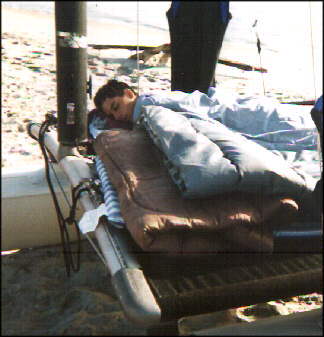 Really serious crew are always in position with jib sheet in hand. Even when sleeping. |
|
The skipper's meeting was a bit shorter on Sunday, since the preliminaries had been gone over the
previous day. What was discussed was much more familiar to us than it had been the previous day. When
we got back to the beach, our friends from Arizona were getting some rigging tips from another sailor.
We observed this stuff, and received some good information on how to get more downhaul and outhaul
tension. We also lowered the shrouds in the chainplates to try and get a bit more rake into the mast.
Our second day racing was a bit better than the first. The slight changes in rigging made a noticable difference in pointing. Also, we were actually position for the start. Once I was familiar with the start sequence, I found it to be quite a rush. The crew has the stopwatch going, and is counting down as the time approaches. The group begins closing towards the line, and when the horn goes off, you hear a lot of skippers sheeting in. One of the starts was so tight Thomas saw a guy move his head around the shroud of another boat while trapped out. The conditions were also much windier, and Thomas and I have done quite a bit of practicing in these conditions. There were a few capsizes, and 2 demastings that I know of. We came in 5th in the first race of the day, and ended up 7th overall. We probably should have hung around for the trophy presentation, but the sailing conditions were some of the best I had seen in a while. We spent the afternoon flying around the bay. Later, when we were leaving, I walked over to Frank Mardel to say goodbye. "Look at that Smile.", he observed. "Did you have a good time?" I assured him that I did, and complimented him on a fine job. To experienced sailors who have never raced, I urge you to give this a try. I've been sailing for close to 30 years, and my learning curve has "flattened" in the last 10 or so. It jumped up dramatically in the 2 days of the San Diego Classic. Sure, I thought I was fast. Of course, the direction I sailed was always dictated by the wind direction, not a stationary mark. As I related this to Matt Miller of Hobie Cat after Saturday's racing, he smiled and mocked "Fastest reach on the beach!" Yes, I believe I'm hooked on this racing thing. If anybody's looking for me on the weekend of July 19-20, I'll be at the Bluewater Regatta in Ventura. Just don't look behind you. I don't plan on "following" this time. Bill Mattson mattson@earthlink.net Back to Features |